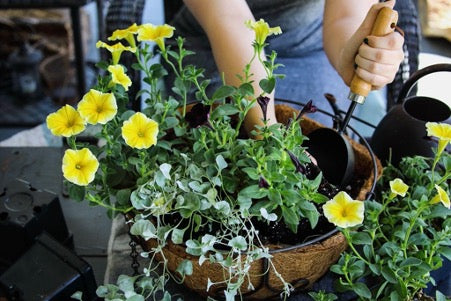Add description, images, menus and links to your mega menu
A column with no settings can be used as a spacer
Link to your collections, sales and even external links
Add up to five columns
Add description, images, menus and links to your mega menu
A column with no settings can be used as a spacer
Link to your collections, sales and even external links
Add up to five columns
Add description, images, menus and links to your mega menu
A column with no settings can be used as a spacer
Link to your collections, sales and even external links
Add up to five columns
Add description, images, menus and links to your mega menu
A column with no settings can be used as a spacer
Link to your collections, sales and even external links
Add up to five columns
by One Click Plants March 20, 2024 4 min read
Hanging baskets are particularly beautiful additions to a garden. A popular type of container amongst British gardeners, they thrive especially well in summer and deliver a stunning display of colour and natural aromas. Plus they attract a variety of species from bees and butterflies to your garden too!
Planting hanging baskets and other containers requires extra planning and care due to the minimal soil space and their unique placement in your garden. So, where to start? Keep reading this blog from our experts for the best advice for planting your hanging baskets and containers.
First things first, is now the right time to plant?
As with any plants, shrub or tree, there’s a particular timing that guarantees the best and healthiest growth. For hanging baskets this will depend on your choice of plants.
Choosing your plants based on the season and also the environment in which you are placing your hanging baskets will guarantee happy plants.
For full sun and summertime baskets and containers, choose the following plants:
Alternatively, you can plant the following bulbs at these particular times for year round displays in your containers and baskets:
Once you have everything you need, you can begin preparing your container or basket for planting. This may include lining the hanging basket if this isn’t included and making sure you have created enough drainage holes for watering. You can then begin to fill your container or basket with a potting mix or your choice of compost.
3. Begin planting your chosen plants
Bulbs - If you are planting bulbs for flowering in a few months, place these on top of your first layer of soil, making sure their pointed end is facing upwards. These bulbs can be planted relatively close to one another. Then you should apply your next layer of compost making sure to cover your bulbs. Depending on the size of your container you can add several layers on top of one another, adding bulbs in between.
Plants - For those planting a particular mix of plants, you can choose to plant them in your desired order. You may want to play around with the colours and height of the plants to create a display that is aesthetically pleasing. Often people will create patterns using different colours and sizes of plants. If you have chosen any trailers, add these to the edge of the basket for a beautiful hanging display.
Once planted, your gardening skill is still required to maintain and care for your new hanging baskets and containers. Watering, in particular, will play a key role in the maintenance of your hanging baskets.
Having a consistent watering routine, particularly during summer and warmer months, will ensure that your hanging baskets thrive. Making sure to water the baskets until your basket is dripping with water guarantees well-hydrated plants. However, be careful to avoid overwatering.
Certain types of summer bedding plants may also benefit from the addition of a liquid fertiliser. Of course, you should check each individual plant and its aftercare notes before using a liquid fertiliser. However, this is a great technique for spring and summer to keep the plants blooming throughout the season.
Deadheading spent flowers will also help to maintain the beautiful appearance of your flowering hanging baskets and containers. Whilst also ensuring a healthy environment for the other plants to grow. This should be done throughout their flowering season, whether this is summer or winter.
For all the tools you need, check out our range of plants and bulbs for hanging baskets and shrubs for containers, as well as compost, fertiliser and baskets.by One Click Plants October 29, 2025 7 min read
Read Moreby One Click Plants October 17, 2025 9 min read
Read Moreby One Click Plants October 08, 2025 8 min read
Read MoreSign up to get the latest on sales, new releases and more …
